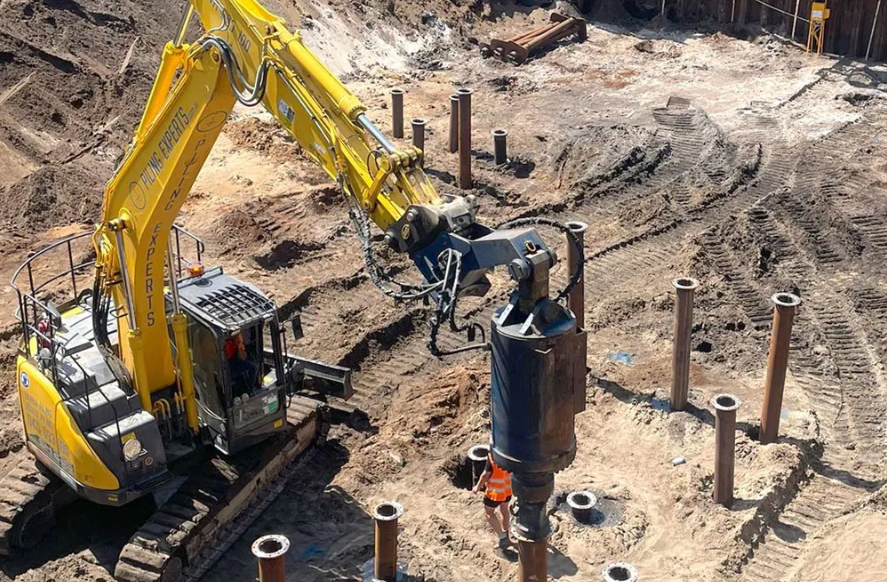A Complete Overview of Screw Pile Installation for Stronger Foundations in Sydney
Building a structure that stands the test of time begins with a solid and reliable foundation. In Sydney, where soil conditions vary across regions and developments range from residential homes to large commercial buildings, one method that has gained popularity for its efficiency and strength is screw pile installation.
Screw piles, also known as helical piers or screw anchors, offer a modern and robust solution to foundation challenges. Unlike traditional concrete footings, they can be installed quickly, cause minimal site disturbance, and are suitable for a wide range of soil types and environmental conditions. Whether you’re constructing a new home, an extension, or a commercial site, screw pile installation ensures a stable and lasting base.
This article explores everything you need to know about screw pile installation—from what it is and how it works, to why it’s especially ideal for Sydney’s construction environment.
What Is Screw Pile Installation?
Screw pile installation is a foundation technique that involves drilling steel shafts with helical plates into the ground until they reach stable load-bearing soil. These piles act like giant screws that anchor the structure above to solid earth below. Once installed, they are either connected to structural supports directly or used as a base for concrete slabs and beams.
Unlike driven piles, which rely on hammering or vibration, screw piles are rotated into the ground using hydraulic equipment. This method offers better control, reduced vibration, and lower environmental impact.
Components of a Screw Pile
A screw pile consists of several key parts:
- Shaft: The main steel tube that provides strength and load transfer.
- Helical Plates: Circular steel blades welded to the shaft that aid in penetration and anchoring.
- Pile Cap or Bracket: The connection between the pile and the foundation, typically customized for the building design.
These components are engineered to support vertical loads, lateral forces, and even uplift resistance, making screw piles versatile and adaptable.
Why Screw Pile Installation Is Ideal for Sydney
Sydney is known for its mixed terrain—from sandy coastal areas to reactive clay in the suburbs. This variation makes it essential to choose a foundation system that can perform reliably under different conditions. Here’s why screw piles are particularly suited to Sydney:
- Adaptable to Different Soils: Screw piles can be installed in soft, sandy, clay, or even semi-rocky soils with great effectiveness.
- Fast and Efficient: In Sydney’s busy construction climate, time matters. Screw pile installation is significantly quicker than traditional methods, reducing construction timelines.
- Minimal Excavation: No need for large digging operations or heavy earthmoving machinery.
- Environmentally Friendly: Lower carbon footprint due to less concrete use and minimal site disruption.
- Weather-Independent: Screw piles can be installed in wet or dry conditions, unlike concrete foundations that require dry curing environments.
Because of these advantages, screw pile installation has become a go-to solution for builders and developers across the Sydney metropolitan area and beyond.
See also: Why First Choice Business Brokers of the Triangle Is the Leading Raleigh Business Broker
The Screw Pile Installation Process
Understanding the step-by-step process of installing screw piles helps demystify the system and highlights its advantages over traditional footings.
Step.1: Site Assessment
The first step involves assessing the site’s soil conditions through geotechnical testing or past experience. This helps determine the correct pile design, depth, and layout.
Step.2: Design and Engineering
Once the soil profile is understood, structural engineers design the piles based on the expected loads of the structure, site-specific factors, and building codes. In Sydney, local regulations must be adhered to, especially for residential developments.
Step.3: Mobilization of Equipment
Screw piles are installed using hydraulic torque motors mounted on small excavators or skid steers. These machines are compact enough to access tight urban spaces, making them ideal for Sydney’s residential suburbs.
Step.4: Installation
The screw piles are positioned according to the foundation plan and drilled into the ground in a clockwise direction. The depth and torque are monitored continuously to ensure the pile reaches suitable load-bearing strata.
Step.5: Load Testing (if required)
Some projects, particularly larger ones or those in challenging soil conditions, require load testing to verify pile performance.
Step.1: Cap and Connection
Once the pile is set, a cap or bracket is welded or bolted to the shaft. This component is used to attach the pile to the rest of the building’s foundation, whether that’s a steel frame, timber structure, or concrete slab.
Applications of Screw Pile Installation
One of the main reasons screw piles are gaining traction is their versatility. They’re used in a wide range of construction projects across Sydney:
- Residential Homes: Perfect for new builds, extensions, decks, and granny flats.
- Commercial Developments: Used for warehouses, modular buildings, and light industrial structures.
- Retaining Walls: Provide anchorage for soil-retaining systems.
- Solar Farms and Signage: Secure poles and arrays without the need for large concrete bases.
- Infrastructure Projects: Ideal for footbridges, pipelines, and utility installations.
In every application, screw piles offer reliable performance, reduced installation time, and environmental benefits.
Benefits of Screw Pile Installation Over Traditional Methods
When comparing screw piles to concrete footings or bored piers, the advantages become evident:
Faster Construction Time
Traditional concrete foundations require excavation, steel reinforcement, pouring, and curing time. Screw piles eliminate most of these steps, allowing for immediate load-bearing capacity and next-day construction progress.
Minimal Site Disruption
Because screw piles require no digging or large machinery, there’s less damage to landscaping and surrounding structures—particularly valuable in heritage areas or tight urban lots in Sydney.
Cost Efficiency
Although material costs may be similar to traditional foundations, the speed of installation and reduced labor requirements often make screw piles more affordable in the long run.
Year-Round Installation
Concrete footings are limited by weather. Rain or cold can delay projects for days. Screw pile installation, on the other hand, is not weather-dependent and can proceed in wet or dry conditions.
Environmentally Friendly
Reduced soil displacement, minimal concrete use, and low-noise equipment all contribute to a more sustainable construction process.
Challenges and Considerations
While screw piles are a strong alternative to traditional foundations, they’re not suitable for every scenario. Here are a few important considerations:
- Rocky Terrain: Very hard or rocky soils may require pre-drilling or specialized equipment.
- Corrosive Soils: In areas with high salt content or acidic soils, piles need to be properly treated or coated.
- Depth Restrictions: Some structures may require piles to reach depths that are impractical with standard screw pile shafts.
A professional contractor will assess your site and recommend the best foundation system accordingly.
Choosing the Right Screw Pile Installation Company
Given the specialized nature of screw piles, it’s essential to choose a contractor with the right expertise, equipment, and track record.
Here’s what to look for:
- Experience in Local Projects: Sydney-based projects demand local knowledge. Contractors who have worked on similar builds will understand local soil conditions and council regulations.
- Qualified Team: Licensed builders and engineers should be involved in the design and installation process.
- Proper Equipment: Screw pile installation requires specific hydraulic torque equipment. Make sure your contractor is well-equipped.
- Comprehensive Services: Look for companies that offer design, supply, installation, and certification in one package.
- Client Reviews and Case Studies: Positive reviews and real-world examples show that a company is reliable and capable.
For builders and homeowners seeking trusted local experts, professional services such as screw pile installation by experienced teams in Wollongong and greater Sydney offer tailored solutions that combine quality, speed, and compliance.
Maintenance and Longevity
One of the best features of screw piles is their long-term durability. When properly installed and protected, screw piles can last as long as the structure itself—often 50 years or more.
Some key aspects of ensuring longevity include:
- Corrosion Protection: Galvanized coatings, epoxy treatments, or stainless-steel materials prevent rust and wear.
- Structural Load Monitoring: Engineers ensure that piles are not overloaded and distribute weight evenly.
- Inspections: Periodic visual checks and documentation keep track of pile integrity, especially if the surrounding soil is prone to movement.
Overall, the maintenance needs of screw piles are minimal, making them a great long-term investment.
Regulations and Compliance in Sydney
Like all foundation systems, screw pile installation in Sydney must meet the standards outlined in the Building Code of Australia (BCA) and local council regulations. Your contractor should provide:
- Engineering Certification: Confirms that the piles have been designed and installed according to structural requirements.
- Installation Records: Documents depth, torque, and positioning for each pile.
- Inspections: Some projects require third-party verification or council inspection before the next stage of construction can proceed.
Always ensure that your screw pile installer is aware of the latest code requirements and licensing obligations.
Conclusion: Build Better with Screw Pile Installation
The foundation is arguably the most critical part of any building. With Sydney’s unique geography and dynamic property market, selecting the right method is crucial to success. Screw pile installation offers a modern, efficient, and reliable foundation system that outperforms many traditional methods in both speed and durability.
From faster construction timelines and reduced environmental impact to adaptability across soil types, screw piles deliver real-world benefits that both builders and homeowners can appreciate. Whether you’re building a dream home in the suburbs, a commercial facility in the city, or supporting infrastructure in challenging terrain, screw piles provide the strength and flexibility required.
To ensure the best results, partner with experienced professionals who understand Sydney’s local conditions and bring a commitment to excellence. When done right, screw pile installation is not just a technique—it’s the solid foundation for your project’s long-term success.






